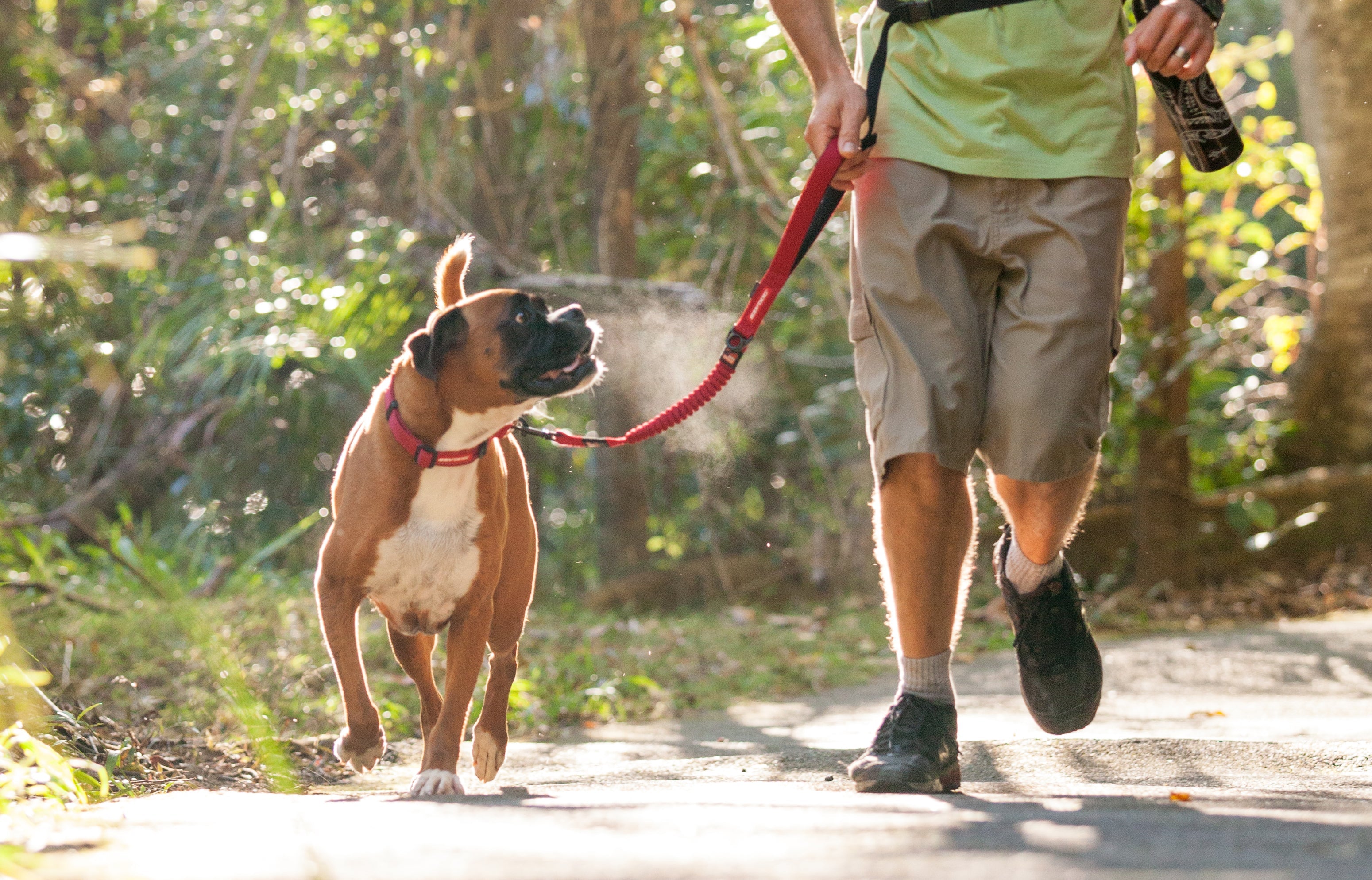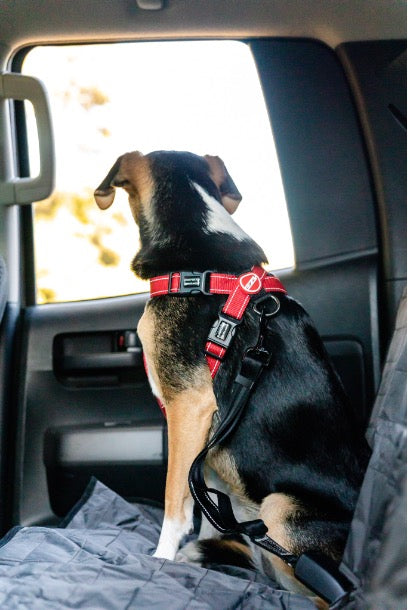Types of Dog Harnesses
Going for a walk is your dog's highlight of the day. The right harness is a must to create a pleasant experience for you and them, but deciding between harnesses is no easy feat. We're here to break down the five types, their advantages and how to choose the right one for your dog.
Here's what you need to know about harnesses for your dog.
Types of Dog Harnesses
There are five types of harnesses to choose from. Several key features distinguish these styles: how the harness is put on, the location of the leash attachment, and the amount of control.
Back-clip Dog Harness

The back clip harness is a harness with a leash clip in the back. They're easy to put on - slide over the dog’s front legs and fasten.
Best for:
- Calm dogs trained not to pull on the leash
- Small dogs with delicate throats easily damaged by collars
Pros:
- Easy to put on and comfortable for dogs
- Prevent strain on dog's neck
- Available in lots of different colors and sizes
Cons:
- Offers little control for dogs that pull or jump on a leash
Front-clip Harness

Front clip harnesses have a leash attachment in the center of a dog’s chest. This harness is good for training your dog not to pull on the leash. The front clip harness allows you to redirect your dog more easily than you could with a traditional collar or harness.
Best for:
- Aggressive or more exuberant dogs (may need additional training tools for an aggressive dog)
- No pull training
Pros:
- Offers better control over dogs that have not had proper training
Cons:
- Leash can tangle under dog's front legs if given more slack
Dual Clip Dog Harness
The dual clip harness has two leash attachment points, on the front and the dog’s back. It also uses a specially designed double-ended leash. This provides great control and can discourage pulling. The dual clip chest harness tends to be a little more expensive, and some dogs experience excess rubbing due to the webbed design.
Best for:
- Dog owners that want a multi-function dog harness
Pros:
- Easily adaptable - can be a front or back clip harness
- Provides control and discourages pulling
Cons:
- Can be more expensive
- Some dogs experience chaffing from webbed design
Tightening Dog Harness
This harness fits comfortably until the dog starts to pull, at which point it begins to tighten. This causes the dog to stop because it wants to avoid the tightness of the harness. It usually has a back clip and you can use a standard leash. This type of harness is a training tool only. When not training, use a gentler, softer harness. You also want to make sure this no-pull harness fits properly so that it doesn’t get too tight, which can lead to aggression and cause injury.
Best for:
- Determined leash pullers
Pros:
- Can lessen pulling
- Usually easy to put on
Cons:
- Can cause pain and negative associations with harnesses
- Does not teach dog to walk loose leash
Head Halter Harness

A head halter fits over the dog’s head with the attachment point under the chin. It guides the dog to keep his attention on what is in front of him and prevent lunging or pulling.
This is not a muzzle and should not cause any pain to the dog’s neck, face, or head, although it may take some time for the dog to get used to wearing it. Avoid yanking or pulling because this can cause pain and injury to the dog’s back. It is also not ideal for dogs with push-in snouts and never to use it with a retractable leash.
Best for:
- Powerful dogs, strong pullers, aggressive dogs, or general dog correction
Pros:
- Works to reduce pulling
Cons:
- Can take some time for the dog to get used to wearing
Dog Harness Styles
All harnesses fit around the dog in some form or fashion and provide more control while you are walking it on a leash. Some have several straps that loop around the dog's belly, back, or chest, while others are designed more like a vest.
There are two basic styles: the strap harness and the vest harness. Each offers certain advantages based on unique features.
Strap Harness vs Vest Harness
A strap harness is good for dogs that don’t pull. The straps vary in width and go around the dog’s shoulders, belly, and chest. They often go over the head and each strap has its own clasp to secure the harness on the dog.

A vest harness provides more coverage over the front of the dog with wider straps and more durable materials. This provides comfort, safety, and control over other harnesses. Some are designed to attach to the seat belt in the car to keep the dog secure while riding – although this is more appropriate for larger dogs.

How to Choose a Harness
You must evaluate your dog carefully and the harness you want to use to find the one that will work best.
- Consider Sizing. Some harnesses are ideal for smaller dogs, while other styles are best suited for larger dogs. Using a harness that is not well suited to the dog's size, breed, or temperament can lead to injury and behavioral issues. If you aren’t sure which harness is best, talk to your veterinarian or a dog trainer for recommendations.
- Dog temperament. Dominant or untrained dogs may pull you, especially if the D ring is on top of the harness, so you would want to get one that hooks in the front.
- Ask your vet. It is never a bad idea to involve your vet in choices you make for your dog, especially regarding restraints like harnesses. Getting the wrong one will cause more problems than it solves.
- Fitting style. Another consideration when purchasing a harness for your dog is how you will get it on them. Some dogs hate to have anything slip over their head. In those cases, a step-in harness may work best. As the name suggests, the dog steps into the harness and is secured on the side or back. This reduces any unpleasant sensory stimulation caused by putting the harness over the head. However, many harnesses do slip over the head, and if it doesn’t bother the dog, it works quite well. An over-the-head harness slips on as a slip-on collar would. The harness straps may be loose, secured, and tightened once the front part is over the dog’s head. Other styles may be secured at all straps and the entire harness slips over the dog’s legs and head.
Dog Harness Fitting Styles

There is really no preferred or “better” style other than what is most comfortable for the dog. And you want to avoid putting undue stress on your dog. While the harness is a must, finding a style they respond to well is very important.
When you fit your dog for a harness, precision matters.Make sure to try the harness on your dog before purchasing and break out the measuring tape for a perfect fit.
Once you have the harness in hand and can put it on your dog you can check the fit to make sure it works. You do this much like you would if you were buying a collar:
- Small dogs – Slip one finger between the harness and the dog’s skin at each strap. If you can do this easily yet the strap is snug, the harness fits. If the straps are very loose, it’s too big. If the straps are tight or you can’t get a finger under there, it’s too tight.
- Large dogs – Slip two fingers between the dog’s skin and the harness at each strap. Just as you would with a small dog, your fingers should fit snugly without pulling. If there is still a lot of room, the harness is too loose; If it is tight, the harness is too tight.
Find a Dog Harness with EzyDog
When you are looking for a harness for your dog, EzyDog has what you need. Shop our wide selection of dog harnesses and accessories to keep your dog safe, secure, and absolutely adorable. Doesn’t your pup deserve the best? We have it!
Reviewed by Experts
This post has been quality-checked by SEO Expert Niraj Raut to ensure it’s clear, helpful, and accurate, and fact-checked by Brady, a dedicated dog expert and enthusiast, to guarantee reliable information for dog owners.


